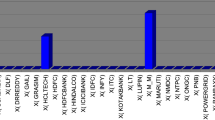Abstract
We consider expected return, Conditional Value at Risk, and liquidity criteria in a multi-period portfolio optimization setting modeled by stochastic programming. We aim to identify a preferred solution of the decision maker (DM) by obtaining information on her/his preferences. We use a weighted Tchebycheff program to generate representative sets of solutions. Our approach models the stochasticity of market movements by stochastic programming. Working with multiple scenario trees, we construct confidence ellipsoids around representative solutions, and present them to the DM for her/him to make a choice. With each iteration of the approach, an increasingly concentrated set of ellipsoids around the DM’s choices are generated. The procedure is demonstrated with tests performed using stocks traded on Borsa Istanbul.



Similar content being viewed by others
Notes
References
Abdelaziz, F. B., Aouni, B., & Fayedh, R. E. (2007). Multi-objective stochastic programming for portfolio selection. European Journal of Operational Research, 177, 1811–1823.
Abdelaziz, F. B., Fayedh, R. E., & Rao, A. (2009). A discrete stochastic goal program for portfolio selection: The case of United Arab Emirates equity market. Information Systems and Operational Research, 47(1), 5–13.
Aouni, B., Abdelaziz, F. B., & Martel, J.-M. (2005). Decision-maker’s preferences modeling in the stochastic goal programming. European Journal of Operational Research, 162, 610–618.
Balibek, E., & Köksalan, M. (2010). A multi-objective multi-period stochastic programming model for public debt management. European Journal of Operational Research, 205(1), 205–217.
Balibek, E., & Köksalan, M. (2012). A visual interactive approach for scenario-based stochastic multi-objective problems and an application. Journal of the Operational Research Society, 63(12), 1773–1787.
Ballestero, E. (2001). Stochastic goal programming: A mean–variance approach. European Journal of Operational Research, 131, 476–481.
Ballestero, E., & Romero, C. (1996). Portfolio selection: A compromise programming solution. Journal of the Operational Research Society, 47(11), 1377–1386.
Bana e Costa, C. A., & Soares, J. O. (2004). A multicriteria model for portfolio management. European Journal of Finance, 10(3), 198–211.
Bodie, Z., Kane, A., & Marcus, A. J. (2009). Investments. New York: McGraw-Hill International Edition.
Buguk, C., & Brorsen, W. (2003). Testing weak-form market efficiency: Evidence from the Istanbul Stock Exchange. International Review of Financial Analysis, 12, 579–590.
Campbell, J. Y., Lo, A. W., & MacKinlay, A. C. (1997). The econometrics of financial markets. Princeton: Princeton University Press.
Dupacova, J., Consigli, G., & Wallace, S. W. (2000). Scenarios for multistage stochastic programs. Annals of Operations Research, 100, 25–53.
Fama, E. F., & French, K. R. (1993). Common risk factors in the returns on stocks and bonds. Journal of Financial Economics, 33, 3–56.
Fang, Y., Xue, R., & Wang, S. (2009). A portfolio optimization model with fuzzy liquidity constraints. In International Joint Conference on Computational Sciences and Optimization, 2009, IEEE, p. 472–476.
Guastaroba, G., Mansini, R., & Speranza, M. G. (2009). On the effectiveness of scenario generation techniques in single-period portfolio optimization. European Journal of Operational Research, 192, 500–511.
Gülpınar, N., Rustem, B., & Settergren, R. (2003). Multistage stochastic mean–variance portfolio analysis with transaction costs. Innovations in Financial and Economic Networks, 3, 46–63.
Haimes, Y. Y., Lasdon, L. S., & Wismer, D. A. (1971). On a bicriterion formulation of the problems of integrated system identification and system optimization. IEEE Transactions on Systems, Man, and Cybernetics, 1(3), 296–297.
Hoyland, K., & Wallace, S. W. (2001). Generating scenario trees for multistage decision problems. Management Science, 47(2), 295–307.
Ibrahim, K., Kamil, A. A., & Mustafa, A. (2008). Portfolio selection problem with maximum downside deviation measure: A stochastic programming approach. International Journal of Mathematical Models and Methods in Applied Sciences, 1(2), 123–129.
Johnson, R. A., & Wichern, D. W. (2002). Applied multivariate statistical analysis. New Jersey: Prentice Hall.
Kaut, M., & Wallace, S.W. (2003). Evaluation of scenario-generation methods for stochastic programming, stochastic programming E-Print series, 14. http://www.speps.org.
Konno, H. (1990). Piecewise linear risk function and portfolio optimization. Journal of Operational Research Society, 33, 139–156.
Konno, H., & Yamazaki, H. (1991). Mean absolute deviation portfolio model and its applications to Tokyo stock market. Management Science, 37, 519–531.
Korhonen, P., & Laakso, J. (1986). A visual interactive method for solving the multiple criteria problem. European Journal of Operational Research, 24(2), 277–287.
Lo, A. W., & MacKinlay, A. C. (1988). Stock market prices do not follow random walks: Evidence from a simple specification test. Review of Financial Studies, 1, 41–66.
MacQueen, J. B. (1967). Some methods for classification and analysis of multivariate observations. In Proceedings of 5th Symposium on Mathematical Statistics and Probability (Vol. 1, pp. 281–297).
Mansini, R., Ogryczak, W., & Speranza, M. G. (2003). On LP solvable models for portfolio selection. Informatica, 14, 37–62.
Mansini, R., Ogryczak, W., & Speranza, M. G. (2007). Conditional value at risk and related linear programming models for portfolio optimization. Annals of Operations Research, 152, 227–256.
Markowitz, H. (1959). Portfolio selection: Efficient diversification of investments. New York: Wiley.
Michalowski, W., & Ogryczak, W. (2001). Extending the MAD portfolio optimization model to incorporate downside risk aversion. Naval Research Logistics, 48, 186–200.
Odabasi, A., Aksu, C., & Akgiray, V. (2004). The statistical evolution of prices on the Istanbul Stock Exchange. The European Journal of Finance, 10, 510–525.
Ogryczak, W., & Ruszczynski, A. (2002). Dual stochastic dominance and quantile risk measures. International Transactions in Operational Research, 9, 661–680.
Pınar, M. Ç. (2007). Robust scenario optimization based on downside-risk measure for multi-period portfolio selection. OR Spectrum, 209, 295–309.
Poterba, J., & Summers, L. (1988). Mean reversion in stock prices: Evidence and implications. Journal of Financial Economics, 22, 27–59.
Rockafellar, R. T., & Uryasev, S. (2000). Optimization of conditional value at risk. Journal of Risk, 2(3), 21–41.
Roman, D., Darby-Dowman, K. H., & Mitra, G. (2007). Mean-risk models using two risk measures: A multi-objective approach. Quantitative Finance, 7(4), 443–458.
Sarr, A., & Lybek, T. (2002). Measuring liquidity in financial markets. In IMF Working Paper, WP/02/232.
Şakar, C. T., & Köksalan, M. (2013a). Effects of multiple criteria on portfolio optimization. International Journal of Information Technology and Decision Making, 13(01), 77–99.
Şakar C. T., & Köksalan, M. (2013b). A stochastic programming approach to multicriteria portfolio optimization. Journal of Global Optimization, 57(2), 299–314.
Seyhun, H. N. (1986). Insiders’ profits, costs of trading and market efficiency. Journal of Financial Economics, 16(2), 189–212.
Smith, G., & Ryoo, H.-J. (2003). Variance ratio tests of the random walk hypothesis for European emerging stock markets. The European Journal of Finance, 9, 290–300.
Steuer, R. E. (1986). Multiple criteria optimization: Theory, computation, and application. New York: Wiley.
Steuer, R. E., Qi, Y., & Hirschberger, M. (2006). Portfolio optimization: New capabilities and future methods. Zeitschrift für Betriebswirtschaft, 76(2), 199–219.
Xidonas, P., Mavrotas, G., & Psarras, J. (2010). Equity portfolio construction and selection using multiobjective mathematical programming. Journal of Global Optimization, 47, 185–209.
Xidonas, P., Mavrotas, G., Zopounidis, C., & Psarras, J. (2011). IPSSIS: An integrated multicriteria decision support system for equity portfolio construction and selection. European Journal of Operational Research, 210(2), 398–409.
Yu, L., Wang, S., Wu, Y., & Lai, K. K. (2004). A dynamic stochastic programming model for bond portfolio management. In Lecture Notes in Computer Science, 3039(2004), pp. 876–883.
Yu, L.-Y., Ji, X.-D., & Wang, S.-Y. (2003). Stochastic programming models in financial optimization: A survey. Advanced Modeling and Optimization, 5(1), 1–26.
Author information
Authors and Affiliations
Corresponding author
Rights and permissions
About this article
Cite this article
Köksalan, M., Şakar, C.T. An interactive approach to stochastic programming-based portfolio optimization. Ann Oper Res 245, 47–66 (2016). https://doi.org/10.1007/s10479-014-1719-y
Published:
Issue Date:
DOI: https://doi.org/10.1007/s10479-014-1719-y




